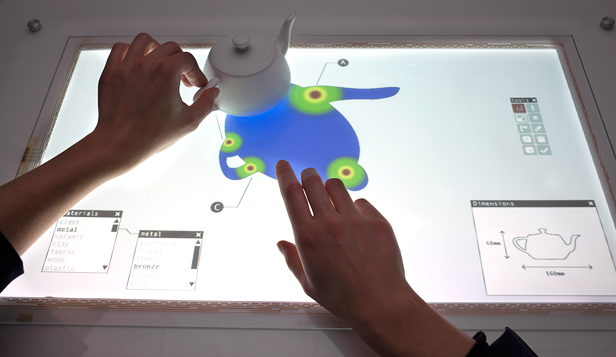Disney researchers add virtual touch to the real world
August 9, 2012
Researchers at Disney demonstrated a computer interface at Siggraph 2012 that changes the way ordinary objects feel, using a weak electric signal fed through a user’s entire body, Technology Review reports.
Wearable technology modifies a user’s tactile perception of the physical world without requiring him/her to wear special gloves or use a force-feedback device. Sensations can be induced when the wearer touches a computer screen, walls, furniture, plastic or wooden objects, even other people.
Reverse electrovibration (REVEL)
The Disney interface exploits a tactile effect known as “reverse electrovibration,” and has been dubbed REVEL. An imperceptible electrical signal is introduced across the user’s whole body to create an oscillating electrostatic field around the skin. When touching a physical object, such as a tablet screen, that shares a common electrical ground with the REVEL signal generator, an electrostatic force modulates the friction between the sliding finger and the object to create the sensation of a texture.
By tracking the objects that a person is touching, an interface could combine augmented reality imagery, on a smartphone or tablet screen, with virtual tactile sensations provided by the REVEL device.
Varying the properties of the signal, such as the shape, amplitude, and frequency, can provide a wide range of tactile sensations, according to Ivan Poupyrev, a Disney research scientist working on the project.
“The sensations at this point are carefully designed and range from feeling virtual pebbles, to fine textures, such as sand, to glassy or rubbery materials, to larger spatial geometrical patterns such as grooves, bumps,” he says. “A lot more work needs to be done to design and investigate really rich tactile sensations with this technology.”
The REVEL device can coordinate tactile sensations with images on almost any surface, including walls and tables, providing they have a conductive element.
Users do not have to be directly connected to the REVEL input via electrodes, because the weak signals sent from the REVEL device, which could be embedded in a chair, a shoe, or the casing of a touch screen, can still pass safely into the user’s body (by capacitive coupling).
Possible applications include guides and augmentation for the blind and, perhaps further in the future, augmented images and films from the entertainment industry — like the “Feelies” Aldous Huxley predicted in his 1932 futurist novel Brave New World.
